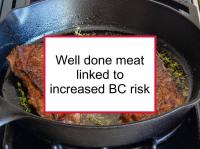Consumption of well-done or fried meat and fish has been found to be associated with increased risk of breast cancer. The association is strongest for red meat (including such common dishes as hamburgers, bacon, pork chops, ribs and other fried or barbecued meat), but is also evident for chicken and fish.
The heightened risk of breast cancer appears to be a result of heterocyclic aromatic amines (HCAs) produced during cooking, especially when using high temperatures. Common HCAs have been shown to be mutagens (heightening cancer risk by increasing the rate of mutations in genes) and to promote cancer in a manner similar to estrogen. Now a new study has explained how various cooking methods affect the HCA content of various meats.
Latest research explains link between well-done meat and BC
The study referenced at the beginning of this news story was designed to summarize existing research regarding food preparation, HCAs and cancer. HCAs are produced during heating as a result of the Maillard reaction, which results in the browning and caramelization of food. High-temperature cooking speeds up this process because it increases both the rate of chemical reactions and the evaporation of water. Epidemiological studies and data based on food frequency questionnaires have reported links between a preference for very well-done meat and enhanced risk of cancer that is not explained by other carcinogens in the diet. While the present report covers various types of cancer, we summarize the relevant findings for breast cancer patients and survivors below:
- HCAs are formed when almost any meat or fish is heated. However, the amount and type is highly dependent on the temperature and type of heat transfer, as well as other factors. Therefore, the concentrations detected in food can vary widely. For example, aging of meat increases the formation of HCAs when the meat is cooked. On the other hand, the presence of some marinades can reduce the formation of HCAs. High HCA concentrations can be found in bacon, although there is no general rule that determines the role of fat in HCA generation.
- Temperature has the greatest influence on HCA formation. The formation of mutagens starts at about 125 °C (257 °F). Length of cooking time and method are also important. The longer the cooking time, the more HCAs are produced even if temperature is held constant. Generally speaking, no significant levels of HCAs or mutagenic activity occur when cooking methods such as stewing, steaming, and boiling are used at temperatures below 120 °C (248 °F). Microwaving is another form of indirect heat transfer that does not generally produce high levels of HCAs. When heat transfer occurs using dry-heating methods involving direct contact with meat or fish (such as pan frying, grilling or roasting), significantly higher mutagen levels are produced. Note that while char is more likely to develop as a result of high heat, it is not necessary for the formation of HCAs.
- Like most carcinogenic substances, HCAs do not act mutagenically immediately upon consumption. They are absorbed in the small intestine, transported to the liver and activated there with the help of metabolic enzymes. There is some evidence that a diet rich in beneficial phenolic compounds could prevent some of the potential damage. It has been demonstrated that the presence of extracts of vegetables and fruit can lead to a reduction in mutagenic activity by HCAs. On the other hand, it is plausible that when additional carcinogens and tumor promoters are ingested along with HCAs in food, they could enhance each others' carcinogenic effects.
